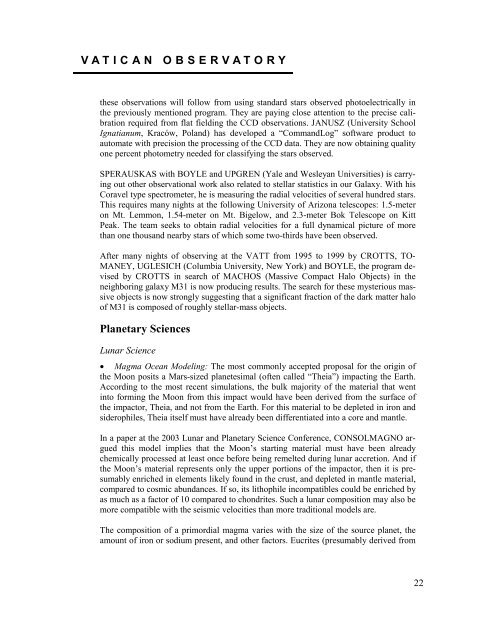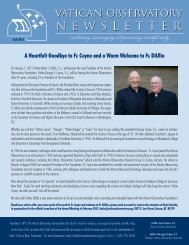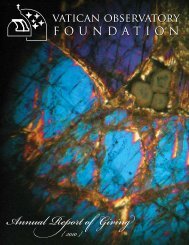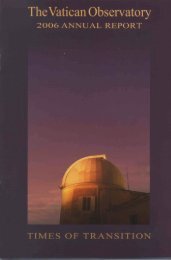Annual Report 2003 - Vatican Observatory
Annual Report 2003 - Vatican Observatory
Annual Report 2003 - Vatican Observatory
You also want an ePaper? Increase the reach of your titles
YUMPU automatically turns print PDFs into web optimized ePapers that Google loves.
VATICAN OBSERVATORYthese observations will follow from using standard stars observed photoelectrically inthe previously mentioned program. They are paying close attention to the precise calibrationrequired from flat fielding the CCD observations. JANUSZ (University SchoolIgnatianum, Kraców, Poland) has developed a “CommandLog” software product toautomate with precision the processing of the CCD data. They are now obtaining qualityone percent photometry needed for classifying the stars observed.SPERAUSKAS with BOYLE and UPGREN (Yale and Wesleyan Universities) is carryingout other observational work also related to stellar statistics in our Galaxy. With hisCoravel type spectrometer, he is measuring the radial velocities of several hundred stars.This requires many nights at the following University of Arizona telescopes: 1.5-meteron Mt. Lemmon, 1.54-meter on Mt. Bigelow, and 2.3-meter Bok Telescope on KittPeak. The team seeks to obtain radial velocities for a full dynamical picture of morethan one thousand nearby stars of which some two-thirds have been observed.After many nights of observing at the VATT from 1995 to 1999 by CROTTS, TO-MANEY, UGLESICH (Columbia University, New York) and BOYLE, the program devisedby CROTTS in search of MACHOS (Massive Compact Halo Objects) in theneighboring galaxy M31 is now producing results. The search for these mysterious massiveobjects is now strongly suggesting that a significant fraction of the dark matter haloof M31 is composed of roughly stellar-mass objects.Planetary SciencesLunar Science• Magma Ocean Modeling: The most commonly accepted proposal for the origin ofthe Moon posits a Mars-sized planetesimal (often called “Theia”) impacting the Earth.According to the most recent simulations, the bulk majority of the material that wentinto forming the Moon from this impact would have been derived from the surface ofthe impactor, Theia, and not from the Earth. For this material to be depleted in iron andsiderophiles, Theia itself must have already been differentiated into a core and mantle.In a paper at the <strong>2003</strong> Lunar and Planetary Science Conference, CONSOLMAGNO arguedthis model implies that the Moon’s starting material must have been alreadychemically processed at least once before being remelted during lunar accretion. And ifthe Moon’s material represents only the upper portions of the impactor, then it is presumablyenriched in elements likely found in the crust, and depleted in mantle material,compared to cosmic abundances. If so, its lithophile incompatibles could be enriched byas much as a factor of 10 compared to chondrites. Such a lunar composition may also bemore compatible with the seismic velocities than more traditional models are.The composition of a primordial magma varies with the size of the source planet, theamount of iron or sodium present, and other factors. Eucrites (presumably derived from22







